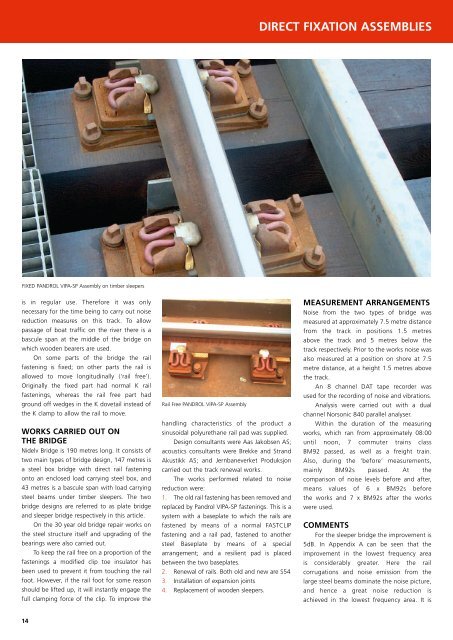direct fixation assemblies - Pandrol
direct fixation assemblies - Pandrol
direct fixation assemblies - Pandrol
Create successful ePaper yourself
Turn your PDF publications into a flip-book with our unique Google optimized e-Paper software.
FIXED PANDROL VIPA-SP Assembly on timber sleepers<br />
is in regular use. Therefore it was only<br />
necessary for the time being to carry out noise<br />
reduction measures on this track. To allow<br />
passage of boat traffic on the river there is a<br />
bascule span at the middle of the bridge on<br />
which wooden bearers are used.<br />
On some parts of the bridge the rail<br />
fastening is fixed; on other parts the rail is<br />
allowed to move longitudinally (‘rail free’).<br />
Originally the fixed part had normal K rail<br />
fastenings, whereas the rail free part had<br />
ground off wedges in the K dovetail instead of<br />
the K clamp to allow the rail to move.<br />
WORKS CARRIED OUT ON<br />
THE BRIDGE<br />
Nidelv Bridge is 190 metres long. It consists of<br />
two main types of bridge design, 147 metres is<br />
a steel box bridge with <strong>direct</strong> rail fastening<br />
onto an enclosed load carrying steel box, and<br />
43 metres is a bascule span with load carrying<br />
steel beams under timber sleepers. The two<br />
bridge designs are referred to as plate bridge<br />
and sleeper bridge respectively in this article.<br />
On the 30 year old bridge repair works on<br />
the steel structure itself and upgrading of the<br />
bearings were also carried out.<br />
To keep the rail free on a proportion of the<br />
fastenings a modified clip toe insulator has<br />
been used to prevent it from touching the rail<br />
foot. However, if the rail foot for some reason<br />
should be lifted up, it will instantly engage the<br />
full clamping force of the clip. To improve the<br />
14<br />
Rail Free PANDROL VIPA-SP Assembly<br />
handling characteristics of the product a<br />
sinusoidal polyurethane rail pad was supplied.<br />
Design consultants were Aas Jakobsen AS;<br />
acoustics consultants were Brekke and Strand<br />
Akustikk AS; and Jernbaneverket Produksjon<br />
carried out the track renewal works.<br />
The works performed related to noise<br />
reduction were:<br />
1. The old rail fastening has been removed and<br />
replaced by <strong>Pandrol</strong> VIPA-SP fastenings. This is a<br />
system with a baseplate to which the rails are<br />
fastened by means of a normal FASTCLIP<br />
fastening and a rail pad, fastened to another<br />
steel Baseplate by means of a special<br />
arrangement; and a resilient pad is placed<br />
between the two baseplates.<br />
2. Renewal of rails. Both old and new are S54<br />
3. Installation of expansion joints<br />
4. Replacement of wooden sleepers.<br />
DIRECT FIXATION ASSEMBLIES<br />
MEASUREMENT ARRANGEMENTS<br />
Noise from the two types of bridge was<br />
measured at approximately 7.5 metre distance<br />
from the track in positions 1.5 metres<br />
above the track and 5 metres below the<br />
track respectively. Prior to the works noise was<br />
also measured at a position on shore at 7.5<br />
metre distance, at a height 1.5 metres above<br />
the track.<br />
An 8 channel DAT tape recorder was<br />
used for the recording of noise and vibrations.<br />
Analysis were carried out with a dual<br />
channel Norsonic 840 parallel analyser.<br />
Within the duration of the measuring<br />
works, which ran from approximately 08:00<br />
until noon, 7 commuter trains class<br />
BM92 passed, as well as a freight train.<br />
Also, during the ‘before’ measurements,<br />
mainly BM92s passed. At the<br />
comparison of noise levels before and after,<br />
means values of 6 x BM92s before<br />
the works and 7 x BM92s after the works<br />
were used.<br />
COMMENTS<br />
For the sleeper bridge the improvement is<br />
5dB. In Appendix A can be seen that the<br />
improvement in the lowest frequency area<br />
is considerably greater. Here the rail<br />
corrugations and noise emission from the<br />
large steel beams dominate the noise picture,<br />
and hence a great noise reduction is<br />
achieved in the lowest frequency area. It is


